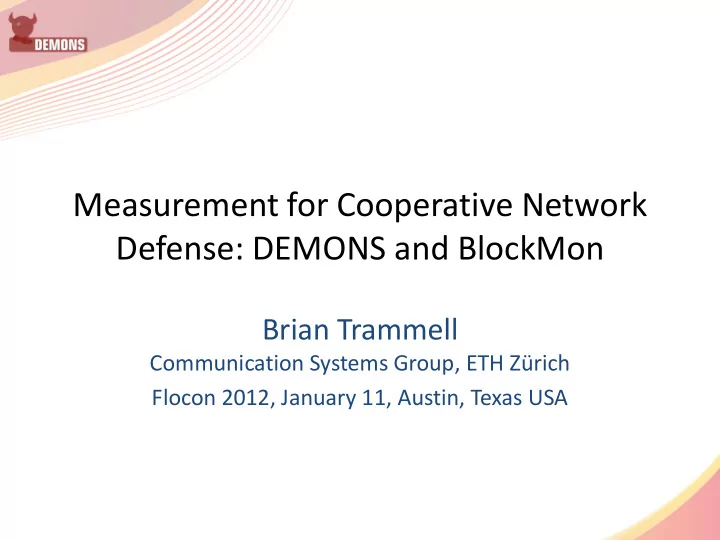

Measurement for Cooperative Network Defense: DEMONS and BlockMon Brian Trammell Communication Systems Group, ETH Zürich Flocon 2012, January 11, Austin, Texas USA
The problem • The attack landscape has become more complex and cooperative. – Botnets, XSS, APT, *(scary_buzzword_ary++) • Network defense remains largely isolated. – Siloed within single administrative domains • Tools and processes for defense must become more cooperative than (implicit) processes for attack. January 11, 2012 DEMONS/BlockMon - Flocon 2012 Austin 2
Centralization of Traffic Data • Passive measurement collects enormous amounts of data. – "Congratulations, you just pointed a ten gig firehose at yourself" • (Almost) all of it is simultaneously – quite sensitive, – and completely uninteresting. January 11, 2012 DEMONS/BlockMon - Flocon 2012 Austin 3
Sharing Traffic Data • Cooperative incident handling requires sharing of data across domains. • Data sharing is fraught with peril. – Legal, regulatory, and business-sensitivity restrictions on data protection and disclosure – Anonymization not a solution to the problem • Pattern injection on Internet traffic practically undetectable [1]; partial offline reversal of anonymization possible. [1] Burkhart et al., "The Role of Network Trace Anonymization Under Attack", ACM Computer Communications Review, vol. 40 no. 1, January 2010 January 11, 2012 DEMONS/BlockMon - Flocon 2012 Austin 4
Cooperative Network Defense DEMONS January 11, 2012 DEMONS/BlockMon - Flocon 2012 Austin 5
The DEMONS Approach Centralized DEMONS January 11, 2012 DEMONS/BlockMon - Flocon 2012 Austin 6
DEMONS: The Project • EC-funded, FP7 ICT IP, Sep 2010–Mar 2013 • Goal: Enable cooperative detection and mitigation of incidents effecting network stability and security. • Consortium of 13 in 9 countries, includes three network operators (Telefónica, FT, TP) January 11, 2012 DEMONS/BlockMon - Flocon 2012 Austin 7
The DEMONS approach: decentralization • Move processing to the edge • Support iterative analysis on live traffic using programmable edge devices. • Emphasize stream processing over retrospective analysis, use existing processes for forensics. • Data reduction on the measurement device improves scalability and reduces sensitivity of collected data. • Integration with existing mitigation processes. January 11, 2012 DEMONS/BlockMon - Flocon 2012 Austin 8
The DEMONS approach: sharing • Share analysis, not data Analyses built by composition • of well-defined processing modules Inspection of intermediate • results before export Application of secure • multiparty computation schemes, where appropriate Realism about technical • limitations of data protection January 11, 2012 DEMONS/BlockMon - Flocon 2012 Austin 9
DEMONS Components and Interfaces • Measurement layer nodes provide capture and analysis. • Interdomain exchange point (IXP) provides "sharing" interfaces to external domains. • Mitigation control point (MCP) provides interface to existing processes. – Additional research within the project WRT policy-driven pseudo-automatic mitigation, MPLS-based quarantining January 11, 2012 DEMONS/BlockMon - Flocon 2012 Austin 10
Composable Network Measurement BLOCKMON January 11, 2012 DEMONS/BlockMon - Flocon 2012 Austin 11
Introducing BlockMon: Goals • Composable measurement using small blocks – Increases parallelizability, measurement performance on multicore hardware – Code reuse for measurement development • Platform for understanding composable measurement application development • Enable code and analysis interchange in the form of compositions of modules from a standard, trusted base January 11, 2012 DEMONS/BlockMon - Flocon 2012 Austin 12
BlockMon • Compositions of blocks exchange messages connected via gates. • Blocks are implemented in C++, framework and scheduling in C++, focus on performance • XML-based composition schema • Python-based CLI and JSON-RPC daemon January 11, 2012 DEMONS/BlockMon - Flocon 2012 Austin 13
BlockMon: out-of-box experience • Core messages, bridged to IPFIX – Packet, with lazy parsing & cache-aware allocation – Flow, allows use of BlockMon as a streaming flow analysis tool – Message base class allows tagging for adding features or annotations to a message in flight • Source, exporter, simple counter blocks • Current work on taxonomy of blocks – filters, metrics, features, correlations, feedback January 11, 2012 DEMONS/BlockMon - Flocon 2012 Austin 14
BlockMon: How fast is fast? Synthetic traffic (10Gbps) Trace replay (6Gbps peak) 10000 1 9000 0.9 8000 0.8 7000 Proportion of packets received 0.7 Data Rate Kbps 6000 0.6 5000 4000 0.5 3000 0.4 2000 0.3 1000 0.2 0 0 500 1000 1500 0.1 Packet Size 0 BlockMon YAF Click CoMo BlockMon YAF Click CoMo January 11, 2012 DEMONS/BlockMon - Flocon 2012 Austin 15
Case Study: VoIPSTREAM Abuse Detection January 11, 2012 DEMONS/BlockMon - Flocon 2012 Austin 16
Play Along at Home • BlockMon to be released as open-source software, BSD licensed. • Development of the core presently very active • Find me this week or e-mail <trammell@tik.ee.ethz.ch> if you're interested. January 11, 2012 DEMONS/BlockMon - Flocon 2012 Austin 17
Conclusions • Current attacks require cooperative defense. • Data sharing is fraught with peril. • Move processing to the edge. • Share analysis, not data. • Composable measurement makes it possible. January 11, 2012 DEMONS/BlockMon - Flocon 2012 Austin 18
Acknowledgments • FP7-DEMONS project – funded by the European Commission • BlockMon Team – NEC Laboratories Europe – CNIT (Consorzio Nationale Interuniversitario per le Telecomunicazioni) January 11, 2012 DEMONS/BlockMon - Flocon 2012 Austin 19
Recommend
More recommend